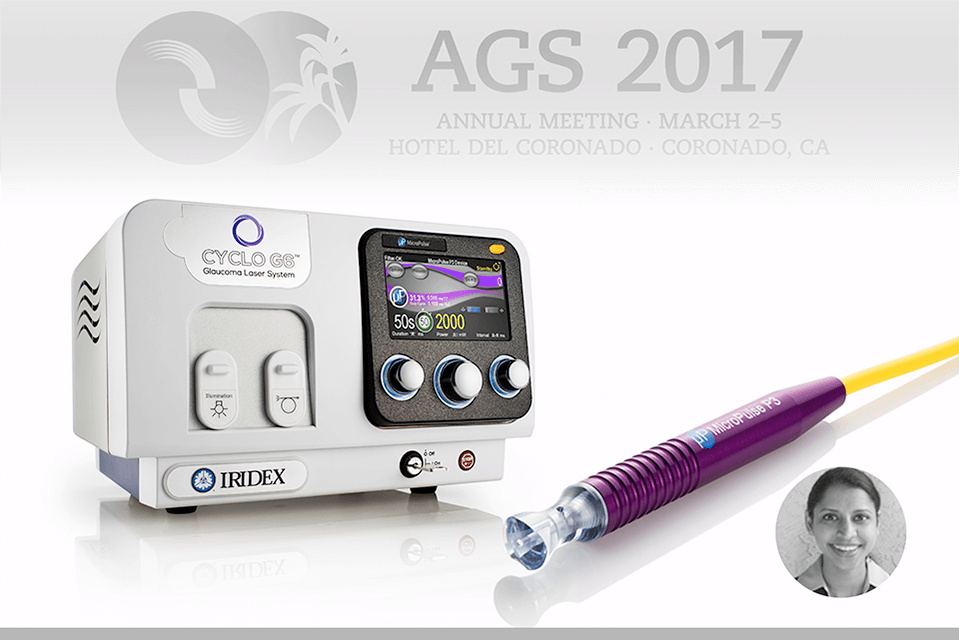
MicroPulse® P3 Glaucoma Device (MP3) Innovative Cyclophotocoagulation with MicroPulse Technology Powered by the NEW CYCLO G6™ Glaucoma Laser System
Source: iridex.com
Micropulse® Cyclophotocoagulation (MP3) Can Be an Effective Glaucoma Treatment
Micropulse Cyclophotocoagulation (MP3) can be an effective glaucoma treatment even in those who have not had prior glaucoma surgery. This was one of the conclusions of a poster presented by S. Radhakrishan et. al. at the American Glaucoma Society (AGS) 2017 Annual Meeting in San Diego, CA.
Unlike prior studies that looked only at those who had failed other surgical treatments, this study also included those who had fewer (or no) glaucoma surgeries. Additionally, a wide variety of glaucoma types were included in the study: primary open angle glaucoma (POAG), primary angle closure glaucoma (PACC), mixed mechanism glaucoma (think of this as both POAG and PACC), pseudoexfolation glaucoma (PXFG), normal tension glaucoma (NTG), steroid associated glaucoma, and neovascular glaucoma (NVG), among others.
With regard to stage of glaucoma, only early visual field defects were present in a third of study participants and most had not had prior incisional glaucoma surgery (though 60% had already been treated with laser trabeculoplasty).
166 eyes of 144 patients were studied. However, the length of this study was short with six month data available for less than one half of study participants.
Average IOP decreased from 22mmHg to 16.7mmHg with a mild decrease in number of medications needed from 3.6 to 3.0.
58% of eyes were considered to have met the definition of “success” (essentially a 20% reduction in IOP). The 42% who failed treatment were evenly divided into those who required additional surgery and those who simply did not achieve a 20% reduction in IOP.
Success appeared to be more likely among female patients and those who received longer duration treatment. Higher initial IOP and severity of glaucoma seemed to be associated with greater risk of failure.
The most common complications included:
- pupil dilation (11%),
- corneal surface drying (7%),
- significant inflammation (3%),
- swelling of the macula (2%), and
- decreased near vision (2%).
One patient in the study (0.6%) did experience a permanent reduction in vision. Of interest is that this patient had received the lower duration treatment.
In summary, this study supports the potential value of Micropulse Cyclophotocoagulation (MP3) at earlier stages of glaucoma. It also reveals that this “gentler” surgery is not without a small risk of vision loss. However, given the higher risk of both non-treatment or traditional glaucoma surgical treatment (trabs and tubes), MP3 still appears to be a welcome and overall lower risk addition to the available surgical glaucoma treatments.

David Richardson, MD
Medical Director, San Marino Eye
David Richardson, M.D. is recognized as one of the top cataract and glaucoma surgeons in the US and is among an elite group of glaucoma surgeons in the country performing the highly specialized canaloplasty procedure. Morever, Dr. Richardson is one of only a few surgeons in the greater Los Angeles area that performs MicroPulse P3™ "Cyclophotocoagulation" (MP3) glaucoma laser surgery. Dr. Richardson graduated Magna Cum Laude from the University of Southern California and earned his Medical Degree from Harvard Medical School. He completed his ophthalmology residency at the LAC+USC Medical Center/ Doheny Eye Institute. Dr. Richardson is also an Ambassador of Glaucoma Research Foundation.


